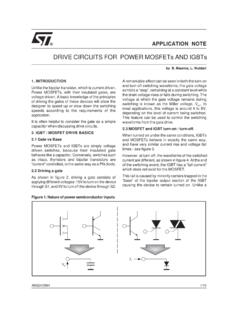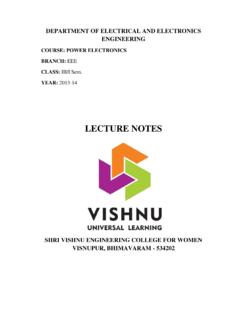Transcription of IGBT datasheet tutorial - STMicroelectronics
1 September 2014 DocID026535 Rev 11/35AN4544 Application noteIGBT datasheet tutorialIntroductionThis application note is intended to provide detailed explanations about parameters and diagrams included in the datasheet of trench- gate field stop IGBTs offered in discrete packages such as: TO-247, TO-220, D2 PAK, etc. This document helps the user to better understand the datasheet parameters and characteristics by explaining the interaction with the influence of conditions as temperature or gate voltage. Thanks to this application note the designer can also use the information included in datasheet according to his needs.
2 datasheet values, for dynamic characterization tests, refer to a specific testing setup with its individual characteristics. Therefore, these values can vary according to the user's of the included diagrams, tables and explanations are related to the STGW40V60DF datasheet . Concerning the latest version of datasheet for this product, please refer to our Rev 1 Contents1 General igbt overview .. technology evolution .. 72 datasheet explanation .. status .. nomenclature meaning .. page of datasheet .. maximum ratings .. voltage (VCES) .. collector current rating (IC) .. biased safe operating area (FBSOA).
3 Of collector current ratings (ICP) .. voltage (VGE) .. power dissipation (PTOT) .. junction and storage temperature range (TJ) and (TSTG) .. resistance (Rth) .. transient thermal impedance (ZthJC) .. characteristics .. saturation voltage - VCE(sat) .. on-voltage (VF) .. cut-off current (ICES) .. leakage current (IGES) .. threshold voltage (VGE(th)) .. characteristics .. , output and reverse transfer capacitances (Cies), (Coes) and (Cres) . capacitance (Cies) .. capacitance (Coes) .. transfer capacitance (Cres) .. charge (Qge), (Qgc) and (Qg) .. switching characteristics (inductive load).
4 Delay time (td(on)) .. rise time (tr) .. current (di/dt(on)) and voltage slope (dv/dt(on)) .. 27 DocID026535 Rev 13 delay time (td(off)) .. time (tf) .. energy (Eon) and (Eoff) .. withstand time - tsc .. switching characteristics (inductive load) .. 313 Revision history .. 34 List of tablesAN45444/35 DocID026535 Rev 1 List of tablesTable maximum ratings showed in absolute maximum ratings .. 10 Table continuous IC in absolute maximum ratings .. 10 Table IC details in absolute maximum ratings.. 13 Table information showed in maximum ratings .. 14 Table total power showed in absolute maximum ratings.
5 15 Table for storage and junction temperature in the table of absolute maximum ratings .. 15 Table maximum ratings for J-C and J-A thermal resistances .. 16 Table characteristics .. 18 Table characteristics .. 21 Table switching characteristics (inductive load) .. 25 Table ratings for short-circuit withstand time .. 30 Table switching characteristics (inductive load) .. 31 Table revision history .. 34 DocID026535 Rev 15/35AN4544 List of figures35 List of figuresFigure section of a trench field-stop igbt .. 6 Figure (a) and simplified equivalent circuits (b) .. 7 Figure technology evolution.
6 7 Figure scheme .. 8 Figure page .. 9 Figure V(BR)CES vs. junction (case) temperature .. 10 Figure to calculate the continuous collector current using the output characteristic curve .. 11 Figure current vs. case temperature .. 12 Figure bias safe operating area .. 13 Figure transfer characteristics .. 14 Figure dissipation vs. case temperature .. 15 Figure resistance scheme .. 16 Figure normalized ZthJC function of pulse duty factor (d) and loading time (tp) .. 17 Figure section of a trench field-stop igbt .. 19 Figure characteristics .. 20 Figure on-voltage .. 20 Figure VGE(th) vs junction temperature.
7 21 Figure section and equivalent model with parasitic capacitances between terminals .. 22 Figure capacitance variation .. 23 Figure charge .. 24 Figure circuit for switching characteristics (inductive load) .. 26 Figure turn-on and turn-off waveforms .. 26 Figure times vs. collector current.. 27 Figure times vs. gate resistance .. 27 Figure losses vs. collector current .. 28 Figure losses vs. gate resistance .. 28 Figure losses vs. junction temperature .. 29 Figure losses vs. collector- emitter voltage .. 29 Figure performance example .. 30 Figure reverse recovery waveform.
8 32 Figure recovery current vs. diode current slope .. 32 Figure recovery time vs. diode current slope.. 32 Figure recovery charge vs. diode current slope .. 33 Figure recovery energy vs. diode current slope .. 33 General igbt overviewAN45446/35 DocID026535 Rev 11 General igbt overviewThe insulated - gate bipolar transistors (IGBTs) combine a MOS gate with high-current and low-saturation-voltage capability of bipolar transistors as illustrated in Figure 1, and they are the right choice for high-current and high voltage applications. igbt and MOSFET operation is very similar. A positive voltage, applied from the emitter to gate terminals, produces a flow of electrons toward the gate terminal in the body region.
9 If the gate to emitter voltage is equal or above the threshold voltage, electrons flow toward the gate to form a conductive channel across the body region, allowing current to flow from the collector-to-emitter. (It allows electrons to flow from the emitter to the collector). This flow of electrons attracts holes, or positive ions, from the p-type substrate to the drift region toward the emitter. The balance in trade-offs among switching speed, conduction loss, and ruggedness is finely tuned and the latest technology, especially for high voltage (> 400 V) devices, improves speed and conduction so that IGBTs are overrun on the high frequency application scenario, which was dominated by Power MOSFET.
10 Figure 2 shows a series of simplified equivalent circuits for an 1. Cross section of a trench field-stop IGBTDocID026535 Rev 17/35AN4544 General igbt overview35 Figure 2. Equivalent (a) and simplified equivalent circuits (b) igbt technology evolutionThe trench field-stop technology includes several benefits if compared to the planar PT (punch through). Implanted back-emitter and field-stop for a better control of the dynamic behavior together with the introduction of the trench structure offer an improved performance like lower conduction and switching loss, much higher robustness and a significant RTH reduction due to very thin 3.











